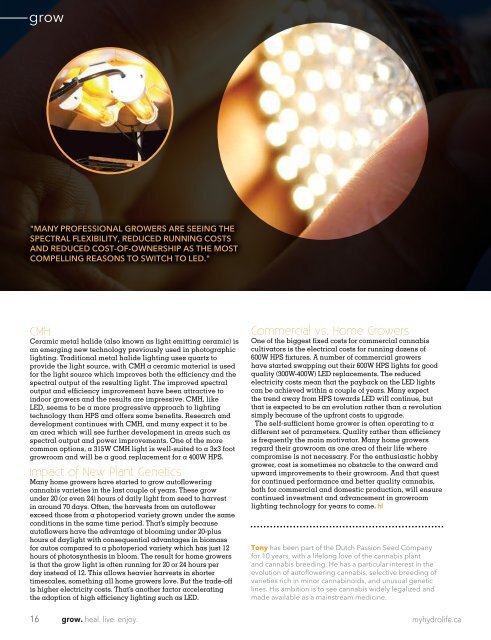Hydrolife Magazine August/September 2016 (Canadian Edition)
Welcome to the third edition of thenew Hydrolife. At this point, all we can say is “wow”. The response from readers, industry professionals and those who use cannabis to heal themselves has blown away all expectations. When we started Hydrolife with a medicinal cannabis theme, our intent was to connect growers, medical practitioners, patients and health enthusiasts by providing information related to this powerful plant. As we continue to do that, it is becoming apparent that passion in the medicinal cannabis revolution runs deep.
Welcome to the third edition of thenew Hydrolife. At this point, all we can say is “wow”. The response from readers, industry professionals and those who use cannabis to heal themselves has blown away all expectations. When we started Hydrolife with a medicinal cannabis theme, our intent was to connect growers,
medical practitioners, patients and health enthusiasts by providing information
related to this powerful plant. As we continue to do that, it is becoming apparent
that passion in the medicinal cannabis revolution runs deep.
Create successful ePaper yourself
Turn your PDF publications into a flip-book with our unique Google optimized e-Paper software.
grow<br />
"MANY PROFESSIONAL GROWERS ARE SEEING THE<br />
SPECTRAL FLEXIBILITY, REDUCED RUNNING COSTS<br />
AND REDUCED COST-OF-OWNERSHIP AS THE MOST<br />
COMPELLING REASONS TO SWITCH TO LED."<br />
CMH<br />
Ceramic metal halide (also known as light emitting ceramic) is<br />
an emerging new technology previously used in photographic<br />
lighting. Traditional metal halide lighting uses quartz to<br />
provide the light source, with CMH a ceramic material is used<br />
for the light source which improves both the efficiency and the<br />
spectral output of the resulting light. The improved spectral<br />
output and efficiency improvement have been attractive to<br />
indoor growers and the results are impressive. CMH, like<br />
LED, seems to be a more progressive approach to lighting<br />
technology than HPS and offers some benefits. Research and<br />
development continues with CMH, and many expect it to be<br />
an area which will see further development in areas such as<br />
spectral output and power improvements. One of the more<br />
common options, a 315W CMH light is well-suited to a 3x3 foot<br />
growroom and will be a good replacement for a 400W HPS.<br />
Impact of New Plant Genetics<br />
Many home growers have started to grow autoflowering<br />
cannabis varieties in the last couple of years. These grow<br />
under 20 (or even 24) hours of daily light from seed to harvest<br />
in around 70 days. Often, the harvests from an autoflower<br />
exceed those from a photoperiod variety grown under the same<br />
conditions in the same time period. That’s simply because<br />
autoflowers have the advantage of blooming under 20-plus<br />
hours of daylight with consequential advantages in biomass<br />
for autos compared to a photoperiod variety which has just 12<br />
hours of photosynthesis in bloom. The result for home growers<br />
is that the grow light is often running for 20 or 24 hours per<br />
day instead of 12. This allows heavier harvests in shorter<br />
timescales, something all home growers love. But the trade-off<br />
is higher electricity costs. That’s another factor accelerating<br />
the adoption of high efficiency lighting such as LED.<br />
Commercial vs. Home Growers<br />
One of the biggest fixed costs for commercial cannabis<br />
cultivators is the electrical costs for running dozens of<br />
600W HPS fixtures. A number of commercial growers<br />
have started swapping out their 600W HPS lights for good<br />
quality (300W-400W) LED replacements. The reduced<br />
electricity costs mean that the payback on the LED lights<br />
can be achieved within a couple of years. Many expect<br />
the trend away from HPS towards LED will continue, but<br />
that is expected to be an evolution rather than a revolution<br />
simply because of the upfront costs to upgrade.<br />
The self-sufficient home grower is often operating to a<br />
different set of parameters. Quality rather than efficiency<br />
is frequently the main motivator. Many home growers<br />
regard their growroom as one area of their life where<br />
compromise is not necessary. For the enthusiastic hobby<br />
grower, cost is sometimes no obstacle to the onward and<br />
upward improvements to their growroom. And that quest<br />
for continued performance and better quality cannabis,<br />
both for commercial and domestic production, will ensure<br />
continued investment and advancement in growroom<br />
lighting technology for years to come.<br />
Tony has been part of the Dutch Passion Seed Company<br />
for 10 years, with a lifelong love of the cannabis plant<br />
and cannabis breeding. He has a particular interest in the<br />
evolution of autoflowering cannabis, selective breeding of<br />
varieties rich in minor cannabinoids, and unusual genetic<br />
lines. His ambition is to see cannabis widely legalized and<br />
made available as a mainstream medicine.<br />
16<br />
grow. heal. live. enjoy.<br />
myhydrolife.ca




![Hydrolife Magazine December 2017/January 2018 [CANADIAN EDITION]](https://img.yumpu.com/59790088/1/190x247/hydrolife-magazine-december-2017-january-2018-canadian-edition.jpg?quality=85)
![Hydrolife Magazine December 2017/January 2018 [USA EDITION]](https://img.yumpu.com/59790042/1/190x247/hydrolife-magazine-december-2017-january-2018-usa-edition.jpg?quality=85)
![Hydrolife Magazine October/November 2017 [Canada Edition]](https://img.yumpu.com/59493562/1/190x247/hydrolife-magazine-october-november-2017-canada-edition.jpg?quality=85)
![Hydrolife Magazine October/November 2017 [USA Edition]](https://img.yumpu.com/59493548/1/190x247/hydrolife-magazine-october-november-2017-usa-edition.jpg?quality=85)
![Hydrolife Magazine August/September 2017 [USA Edition]](https://img.yumpu.com/59236656/1/190x247/hydrolife-magazine-august-september-2017-usa-edition.jpg?quality=85)









